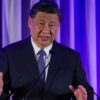Technology
Europe units its attractions on multi-billion-euro gigawatt factories because it performs catch-up on AI
Information warehouse tapes are saved on the Nationwide Power Analysis Medical Computing Heart (NERSC) facility on the Lawrence Berkeley Nationwide Laboratory, which is able to space the U.S. supercomputer to be powered through Nvidia’s impending Vera Rubin chips, in Berkeley, California, U.S. Would possibly 29, 2025.
Manuel Orbegozo | Reuters
Europe is atmosphere its attractions on gigawatt factories in a bid to reinforce its lagging synthetic understanding trade and meet the demanding situations of a rapidly-changing sector.
Buzz round the concept that of factories that industrialize production AI has received garden in fresh months, specifically as Nvidia CEO Jensen Huang wired the virtue of the infrastructure at a June match. Huang hailed a fresh “industrial revolution” on the GTC convention in Paris, France, and said his company used to be operating to backup international locations develop revenue-generating AI factories via partnerships in France, Italy and the U.Ok.
For its phase, the Ecu Union describes the factories as a “dynamic ecosystem” that brings in combination computing energy, information and ability to assemble AI fashions and programs.
The bloc has lengthy been a laggard in the back of the U.S. and China within the race to scale up synthetic understanding. With 27 individuals within the union, the area is slower to behave in relation to agreeing fresh regulation. Upper power prices, allowing delays and a grid in dire want of modernization too can impede tendencies.
Henna Virkkunen, the Ecu Fee’s government vice chairman for tech self rule, advised CNBC that the bloc’s function is to deliver in combination top component information units, computing capability and researchers, multi functional playground.
“We have, for example, 30% more researchers per capita than the U.S. has, focused on AI. Also we have around 7,000 startups [that] are developing AI, but the main obstacle for them is that they have very limited computing capacity. And that’s why we decided that, together with our member states, we are investing in this very crucial infrastructure,” she mentioned.
Those are very large investments as a result of they’re 4 occasions extra tough in relation to computing capacities than the largest AI factories.
Henna Virkkunen
Ecu Fee’s government vice chairman for tech self rule
“We have everything what is needed to be competitive in this sector, but at the same time we want to build up our technological sovereignty and our competitiveness.”
Thus far, the EU has publish 10 billion euros ($11.8 billion) in investment to arrange 13 AI factories and 20 billion euros as a initiation level for funding within the gigafactories, marking what it says is the “largest public investment in AI in the world.” The bloc has already gained 76 expressions of pastime within the gigafactories from 16 member states throughout 60 websites, Virkkunen mentioned.
The decision for pastime in gigafactories used to be “overwhelming,” going a ways past the bloc’s expectancies, Virkkunen famous. On the other hand, to bring for the factories to construct a worthy addition to Europe’s computing capability, considerably extra funding can be required from the non-public sector to investmrent the pricy infrastructure.
‘Judgement revolution’
The EU describes the amenities as a “one-stop shop” for AI companies. They’re meant to reflect the method performed in commercial factories, which grow to be uncooked fabrics into items and products and services. With an AI manufacturing unit, uncooked information is going into the enter, and complicated AI merchandise are the predicted consequence.
It’s necessarily an information middle with backup infrastructure alike to how the era can be followed, in line with Andre Kukhnin, fairness analysis analyst at UBS.
“The idea is to create GPU [graphics processing units] capacity, so to basically build data centers with GPUs that can train models and run inference… and then to create an infrastructure that allows you to make this accessible to SMEs and parties that would not be able to just go and build their own,” Kukhnin mentioned.
How the power can be worn is vital to its designation as an AI manufacturing unit, provides Martin Wilkie, analysis analyst at Citi.
“You’re creating a platform by having these chips that have insane levels of compute capacity,” he mentioned. “And if you’ve attached it to a grid that is able to get the power to actually use them to full capacity, then the world is at your feet. You have this enormous ability to do something, but what the success of it is, will be defined by what you use it for.”
Telecommunications company Telenor is already exploring possible use cases for such facilities with the launch of its AI factory in Norway in November last year. The company currently has a small cluster of GPUs up and running, as it looks to test the market before scaling up.
Telenor’s Chief Innovation Officer and Head of the AI Factory Kaaren Hilsen and EVP Infrastructure Jannicke Hilland in front of a Nvidia rack at the firm’s AI factory
Telenor
“The journey started with a belief — Nvidia had a belief that every country needs to produce its own intelligence,” Telenor’s Chief Innovation Officer and Head of the AI Factory Kaaren Hilsen told CNBC.
Hilsen stressed that data sovereignty is key. “If you want to use AI to innovate and to make business more efficient, then you’re potentially putting business critical and business sensitive information into these AI models,” she said.
The company is working with BabelSpeak, which Hilsen described as a Norwegian version of ChatGPT. The technology translates sensitive dialogues, such as its pilot with the border police who can’t use public translation services because of security issues.
We’re experiencing an “intelligence revolution” whereby “sovereign AI factories can really help advance society,” Hilsen said.
Billion-euro investments
Virkkunen said the region’s first AI factory will be operational in coming weeks, with one of the biggest projects launching in Munich, Germany in the first days of September. It’s a different story for the gigafactories.
“These are very big investments because they are four times more powerful when it comes to computing capacities than the biggest AI factories, and it means billions in investments. Each of these need three to five billion [euros] in investment,” the commissioner said, adding that the bloc will look to set up a consortium of partners and then officially open a call for investment later this year.
Bertin Martens, senior research fellow at Bruegel, questioned why such investments needed to subsidized by government funds.
“We don’t know yet how much private investment has been proposed as a complement to the taxpayer subsidy, and what capacity and how big these factories are. This is still very much unclear at this stage, so it’s very hard to say how much this will add in terms of computing capacity,” he said.
Power consumption is also a key issue. Martens noted that building an AI gigafactory may take one to two years — but building a power generation of that size requires much more time.
“If you want to build a state-of-the-art gigafactory with hundreds of thousands of Nvidia chips, you have to count on the power consumption of at least one gigawatt for one of those factories. Whether there’s enough space in Europe’s electricity grid in all of these countries to create those factories remains to be seen… this will require major investment in power regeneration capacity,” he told CNBC.
UBS forecasts that the current installed global data center capacity of 85 GW will double due to soaring demand. Based on the EU’s 20-billion-euro investment and the plan for each factory to run 100,000 advanced processors, UBS estimates each factory could be around 100-150 MW with a total capacity for all of the facilities of around 1.5-2 GW.
That could add around 15% to Europe’s total capacity — a sizeable boost, even when compared to the U.S., which currently owns around a third of global capacity, according to the data.
Following the announcement of the EU-U.S. trade framework, EU chief Ursula von der Leyen said Sunday that U.S. AI chips will backup energy the bloc’s AI gigafactories in a bid to backup the States “maintain their technological edge.”
“One could argue that it’s relatively easy, provided you have the money. It’s relatively easy to buy the chips from Nvidia and to create these hardware factories, but to make it run and to make it economically viable is a completely different question,” Martens advised CNBC.
He mentioned that the EU will most likely have to start out at a smaller scale, because the area is not able to in an instant develop its personal frontier fashions in AI as a result of their expense.
“I think in time, Europe can gradually build up its infrastructure and its business models around AI to reach that stage, but that will not happen immediately,” Martens mentioned.





